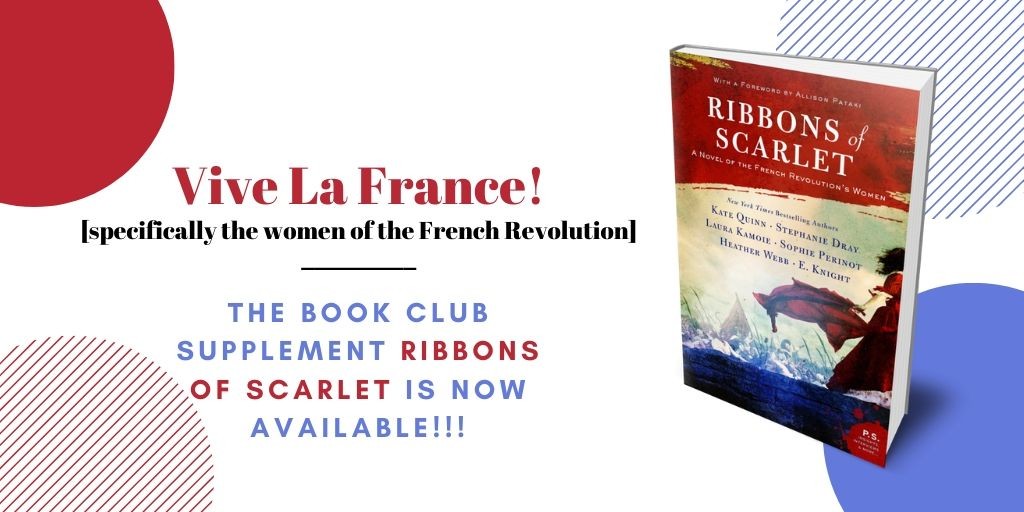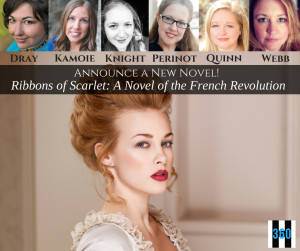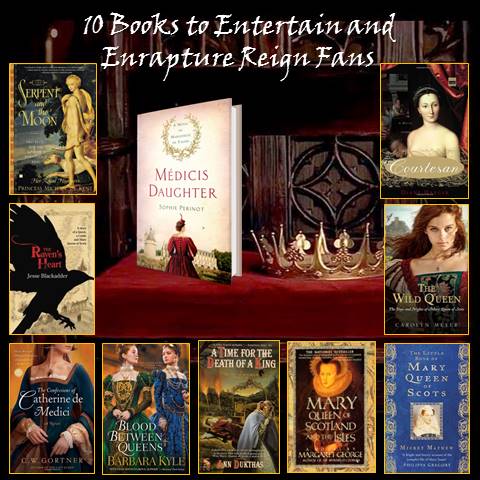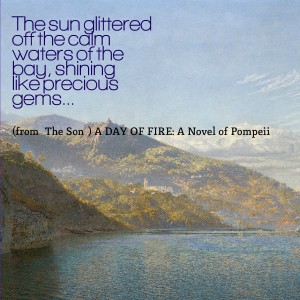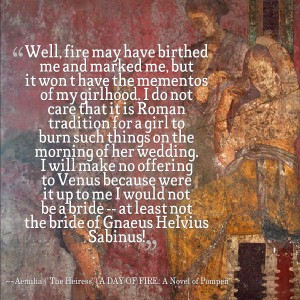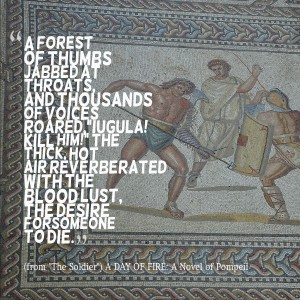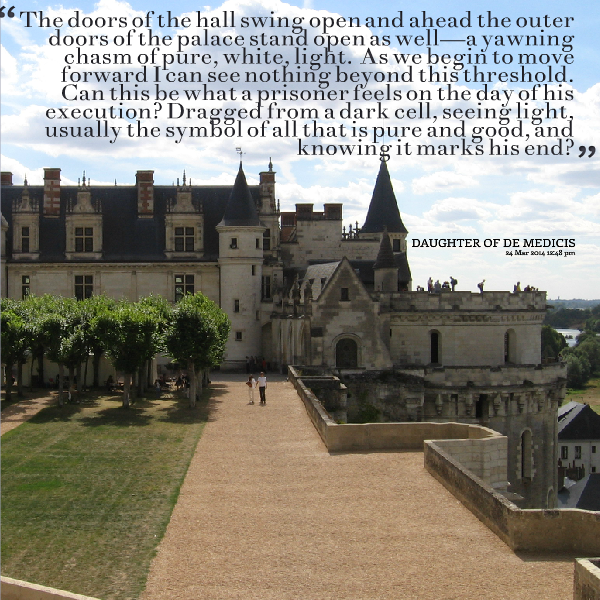Tag: historical fiction
Just a little reminder . . . Books make great gifts!
This year a took a magical pre-holiday trip to Spain. But–oops–that means the holidays are upon me and I am NOT read. As in . . . I have purchased a grand total of three gifts so far.
Thank heavens for BOOKS! I’d argue there is a book out there for everyone. Are you still shopping as well? Maybe someone on your list would enjoy one of my novels?!
Medicis Daughter — 16th Century Royal Drama. Visit the gorgeous palaces of the Loire valley and streets of Paris with French Princess Marguerite de Valois. But be careful, Marguerite’s mother, Queen Catherine de Médicis is always plotting something . . . and a wrong move could be your last. Oh, and if you are invited to Marguerite’s wedding (her heart belongs to the handsome Duc de Guise, but her hand will be offered to Henri of Navarre, a Huguenot leader and a notorious heretic looking to seal a tenuous truce) you’d better dress for a massacre as well as dancing.
⚜ BUY LINKS FOR MÉDICIS DAUGHTER ⚜
Amazon
Bookshop Org
The Sister Queens — A story of 13th Century Sisterhood. Pass a cold winter’s day with Marguerite, Queen of France and her beloved sister Eleanor Queen of England . . . Raised at the court of their father, the Count of Provence, Marguerite and Eleanor are separated by these royal marriages–but never truly parted. Marguerite is the more patient and perfect of the pair . . . used to being first. She wants to be a good wife and a good Queen, but her husband Louis IX is a religious zealot who denies himself the love and companionship his wife craves. Can Marguerite borrow enough of her sister’s boldness to grasp her chance for happiness in a forbidden love?
♔BUY LINKS FOR THE SISTER QUEENS ♔
Amazon
Bookshop Org
And by Fire — A twisty mystery with a dose of 15th Century history. Written by my alter-ego, Evie Hawtrey. Tempered by fire and separated by centuries, two extraordinary female detectives track a pair of murderous geniuses who will burn the world for their art in this mystery perfect for fans of Sarah Penner and Dan Brown.
Nigella Parker, Detective Inspector with the City Police, has a deeply rooted fear of fire and a talent for solving deadly arson cases. When a charred figure is found curled beside Sir Christopher Wren’s Monument to the Great Fire of London, Nigella is dragged into a case pitting her against a murderous artist creating sculptures using burnt flesh.
Nigella partners with Colm O’Leary of Scotland Yard to track the arsonist across greater London. The pair are more than colleagues—they were lovers until O’Leary made the mistake of uttering three little words. Their past isn’t the only buried history as they race to connect the dots between an antique nail pulled from a dead man’s hands and a long-forgotten architect dwarfed by the life’s work of Sir Christopher Wren.
Wren, one of London’s most famous architects, is everywhere the pair turn. Digging into his legacy leads the DCIs into the coldest of cold cases: a search for a bookseller gone missing during the Great Fire of London. More than 350 years earlier, while looking for their friend, a second pair of detectives—a lady-in-waiting to the Queen and a royal fireworks maker—discovered foul play in the supposedly accidental destruction of St. Paul’s Cathedral…but did that same devilry lead to murder? And can these centuries-old crimes help catch a modern-day murderer?
As Nigella and O’Leary rush to decode clues, past and present, London’s killer-artist sets his sights on a member of the investigative team as the subject of his next fiery masterpiece.
BUY LINKS FOR AND BY FIRE
Amazon US
Bookshop . org
Barnes and Noble
Ribbons of Scarlet—a tale of the women of the French Revolution. Feel like starting a revolution? You’re in good company. Travel to 18th century Paris and meet seven amazing French women who fomented and fought in the French Revolution. Ribbons is a breathtaking epic novel illuminating the hopes, desires, and destinies of princesses and peasants, harlots and wives, fanatics and philosophers—unforgettable women who leave their distinctive marks on one of the most tumultuous and transformative events in history. But if anyone offers you a ride in a Tumbril just say NO!
BUY LINK FOR RIBBONS OF SCARLET
Amazon Paperback
A Day of Fire — A visit to the doomed city of Ancient Pompeii. Pompeii was a lively resort flourishing in the shadow of Mount Vesuvius at the height of the Roman Empire. When Vesuvius erupted in an explosion of flame and ash, the entire town would be destroyed. Some of its citizens died in the chaos, some escaped the mountain’s wrath . . . Six authors bring to life overlapping stories of patricians and slaves, warriors and politicians, villains and heroes who cross each others’ path during Pompeii’s fiery end. But who will escape, and who will be buried for eternity?
BUY LINK FOR A DAY OF FIRE
Amazon

Interview with Laura Morelli, Author of THE GIANT
If you’ve been to Florence you’ve seen Michelangelo’s David. If you haven’t been to Florence you’ve seen countless images of him. The David is a cultural icon and even 500 years after his creation still has the power to leave us awe struck.
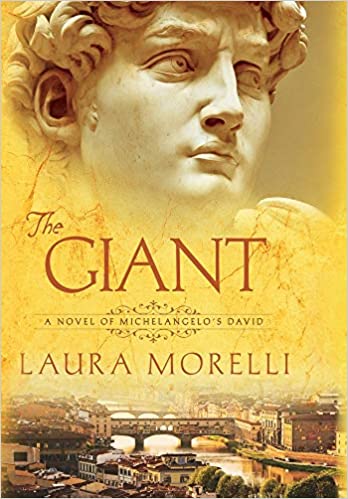
Now Laura Morelli—talented novelist and PhD Art Historian—has a breathtaking new novel out about the creation of this Renassaisance Art Masterwork, and I am THRILLED to welcome her to my blog today to talk about the process of creation for both her novel, THE GIANT, and Michelangelo’s David!
Let’s start things off with a teaser for THE GIANT . . . .
As a colossal statue takes shape in Renaissance Florence, the lives of a master sculptor and a struggling painter become stunningly intertwined.
Florence, 1500. Fresco painter Jacopo Torni longs to make his mark in the world. But while his peers enjoy prestigious commissions, his meager painting jobs are all earmarked to pay down gambling debts.
When Jacopo hears of a competition to create Florence’s greatest sculpture, he pins all his hopes on a collaboration with his boyhood companion, Michelangelo Buonarroti. But will the frustrated artist ever emerge from the shadow of his singularly gifted friend?
From the author of THE PAINTER’S APPRENTICE and THE GONDOLA MAKER comes a gorgeously crafted, immersive tale of Renaissance Italy.
Laura, I have such distinct memories of the first time I stood in front of Michelangelo’s David—gape-mouthed and totally in awe. What do you think draws people to the David?
Me too! I am always amazed at the number of people who tell me that this sculpture is the thing that impressed them the most on a trip to Italy.
In fact, when my family returned from Italy last summer, I asked my four teenagers to name the top three favorite things they saw. The David was on the top of each of their lists (and I promise I tried not to influence their choices!). I think that’s amazing.

A Time Magazine article in the 1980s reported on the “emotional trauma” experienced by first-time viewers of the David. And a few visitors have even tried to disrobe before the statue, only to be quickly led away by museum guards!
I have long wondered what it was about this statue and the irreverent stone carver who made it that still has the power to capture people’s imagination–to make their jaws drop, to leave them speechless–even in our current time of multimedia overload. And even after studying it for some thirty years, I’m still not convinced it’s something that can be put 100% into words. That’s the power of art!
As a PhD art historian, how do you think the David influenced the course and direction of art at the moment of its unveiling and in the aftermath of its creation?
The David was the first colossal nude on Italian soil since ancient Roman times. Think about that… For a thousand years, no one had seen a nude male sculpture of this scale. But this David is actually a biblical hero in the guise of an ancient god, at the same time that he appears as a god in the image of a perfect man. He is both an Adam and a Hercules, both a Christian and a civic / political symbol. In short, the David seems to telescope all the aspirations and the ideals of the High Renaissance in a single work of art. I don’t think any sculptor who worked in Europe after 1504 could ignore it. Later works, like those of Gianlorenzo Bernini, would have been unimaginable without Michelangelo’s precedent.
Sometimes truth really is stranger than fiction. Can you share a fact or scene from The Giant which actually happened (or existed), but seems too strange to be true?
We have an amazing contemporary account of the sculpture leaving the cathedral workyard, where Michelangelo had been working on it for four years. At midnight on May 4, 1504, laborers broke the stone lintel above the gate of the workyard and began to move the sculpture slowly toward the Piazza della Signoria. They suspended the sculpture from a contraption made of ropes and pulleys, as well as greased logs to roll it forward. It took several days to reach its intended location. During that time, some boys were arrested for throwing stones at it; one of them turned out to be a relative of Lisa Gherardini—yes, the Mona Lisa (whose portrait Leonardo da Vinci was painting at the time, just a few streets away). You can’t make this stuff up!
Of course Michelangelo is not the only artist in The Giant . . . can you tell us a little bit about Jacopo Torni (or the artist he is based upon) and why you felt his story needed to be told?
As I looked for the right person to tell the story of Michelangelo’s gigante, I came across historical references to a Florentine fresco painter called Jacopo Torni, also known as L’Indaco.
The sixteenth-century art historian Giorgio Vasari tells us that L’Indaco lived “in close intimacy” with Michelangelo, and that Michelangelo found L’Indaco the funniest and most entertaining of his friends. We also know that Michelangelo invited L’Indaco to work with him on the Sistine Chapel in 1508. According to some sources, it was a friend who convinced Michelangelo to return to Florence to take on the David commission in 1501, and I like to think it was L’Indaco.
Michelangelo is one of the most notoriously temperamental artists in history, and I wondered about this relationship of seeming opposites. It is this push and pull of two creative friends, in combination with the creation of two of the most seminal works of art history—the David and the Sistine Chapel ceiling—that drew me to this story and made me want to explore this complicated friendship further.
Finally, I’d like to close out things with a Rapid Fire round:
- Favorite Italian dish: Risotto alla milanese, without a doubt!
- Character you’d love to write about but probably never will: A living artist.
- Why won’t you? It would be so tricky, I think, to write fiction or nonfiction about a real person who is either living or recently deceased.
- A piece of art that is special to you other than the David: I saw the cathedral of Notre Dame in Paris when I was 12 years old, and it was a “coup de foudre.” It led me to want to pursue art history and it’s still such a special building to me.
- Do you write to music or in silence? I love peace and quiet when I write.

Thanks so much to Laura for stopping by! Don’t forget to pick up your copy of THE GIANT readers—at Amazon, Indiebound, on Bookshop.org to support Independent booksellers, or your favorite local bookstore!
RIBBONS OF SCARLET Book-Club Bonus Materials Are Here!!!
Do you adore historical fiction about strong women? Are you a book club member (perhaps in a club full of strong women)? When making your fall and winter reading selections I urge you to consider Ribbons of Scarlet!
Not only is it a timely story about the power of women to start a Revolution and change the world . . . we have a treasure-trove of supplemental materials for book club readers!!!
Yes indeed, our marvelous publisher has created a Ribbons of Scarlet book club supplement complete with deleted scenes—including one from my chapter THE PRINCESS about the King’s sister Madame Élisabeth—some menus ideas rooted in the gastronomy of 18th century France, humorous insights into our collaborative process, and of course cocktail choices based on your Revolutionary politics.
I will give you one guess who was the team’s cocktail creator. That’s right mes amis – moi, moi-même! I may not be a professional mixologist, but I did my reading and I am certainly a cocktail enthusiast. After crafting several versions of my Philosophe and Aristo I assembled my (eager) family as taste-testers. So check out the supplement, give the drinks a try and PLEASE let me know which is your favorite!
Oh and just so you don’t have to feel even the slightest bit guilty—I made sure to write a nice little article on the links between the Revolution and alcohol. Did you know, for example, that even as the Bastille was being stormed so were the Paris Custom Gates because the tax on wine was a VERY contentious issue!
Download your copy of the Book Club Supplement today
RibbonsofScarlet_BonusMaterials
then read up and drink up! À Votre Santé!
Holiday Season SPECIAL PRICING on Medicis Daughter!!!
It’s that time of year again readers . . . time for my holiday gift-giving special! This year’s price for SIGNED COPIES of Médicis Daughter will be $11.00 per hardcover, shipping included.
Visit the official Médicis Daughter Facebook page for more details and to message me with an order.
ANNOUNCING RIBBONS OF SCARLET!!!
Dear faithful fans and readers,
I am over the moon to be able to AT LAST share this BIG NEWS with you! Fall 2019 will see some new Sophie Perinot (written in conjunction with my brilliant co-authors from History 360: The Historical Fiction Collective) on sale and shelves everywhere—a revolutionary telling of the French revolution from a purely female perspective! Here is the deal announcement from Publishers Marketplace:
RIBBONS OF SCARLET, a novel about the women of the French Revolution, featuring royals and peasants, harlots and wives, and fanatics and philosophers across the political spectrum who plotted, fought, marched, and crossed each other’s paths at Versailles and on the tumultuous streets, in an attempt to defend their beliefs, open new doors for women, and create a bold and equal new world–by bestselling authors Kate Quinn, Laura Kamoie, Stephanie Dray, E. Knight, Heather Webb and Sophie Perinot, at auction to Tessa Woodward at William Morrow by Kevan Lyon at Marsal Lyon Literary Agency in a good deal.
We are looking at an Autumn 2019 release. BELIEVE ME you have NEVER read anything like this. So mark your calendars and, to make certain you don’t miss the cover release or any extra snippets and goodies, if you are on Facebook, please to LIKE/FOLLOW all of our author pages!
[Facebook Author page links: Moi, Stephanie, Laura, Eliza, Kate and Heather]
10 Books to Entertain and Enrapture Reign Fans Waiting for Season Four
Season 3 of the CW’s Reign is a wrap, and fans are in mourning—and not just over the death of . . . no wait, no spoilers in case some of you have DVRed the Season Finale but not watched it yet. No what’s really got fans crying are the ugly rumors that Summer 2017 is the earliest Reign will return. What will we all do for our 16th century French/Scottish fix in the intervening months?
Never fear, mes amies! An evening with the feisty-yet-tragic Mary Queen of Scots, or the cunning Catherine de Médicis is only a bookstore (or library) visit away.
I’ve combed through my personal shelves and reached out to some book blogger friends to compile this list of TEN BOOKS TO ENTERTAIN AND ENRAPTURE REIGN FANS while the show is on hiatus (and I want you all to remember I scooped Buzzfeed Books on this one). These books will take you to the intrigue-filled French and Scottish courts, and satiate your cravings for things royal:
#1 Médicis Daughter by Sophie Perinot: It is my blog, so I get to lead with my book but that’s not naughty because the critics agree the book is oh so nice—
“Brilliant. This is what I call a ‘WOW’ book.” “I have re-read this book not once but TWICE, it’s that good!!!”~Book Lovers’ Paradise
This novel of Valois family dysfunction, political treachery, forbidden love and bloodiest massacre in French history has been called, “A riveting page-turner skillfully blending illicit liaisons and political chicanery.” (~Kirkus Reviews). It was selected as one of Goodreads “Best Books of the Month: December 2015” (the month it released), and also as a B&NReads, December’s Top Pick in Fiction.
More importantly for Reign fans, Amazon reviews suggest Médicis Daughter “would be a great gift for any … fan of the show Reign.”
Médicis Daughter takes readers into the post-Francis Valois landscape (which is precisely where Season 3 left us hanging). With King Charles IX on the throne and Catherine de Médicis pulling the strings and plotting the plots (some things never change), you KNOW there will be plenty of dark and dirty. Viewed through the eyes of the youngest Valois Princess, Marguerite, the court comes alive. As Erin at Flashlight Commentary (see her book recommendation at #7 below) says: “Atmospherically, the novel swept me off my feet. Perinot’s depiction of the French court was beautifully drawn and I was wholly captivated by both the political and social interaction that unfolded among its players.” [Erin’s full review is here].
♥Recommended for Reign fans who enjoy the lush, dark side of the Valois court—the poisonings, the sexual decadence, the back-room deals—and also those who rooted for Princess Claude to outmaneuver her domineering mother.♥
#2 The Serpent and the Moon by HRH Princess Michael of Kent: Instead of heading forward, travel backward to the pre-Reign Valois world with this fascinating volume of popular history. This book relates the true story of the battle between Catherine de Médicis and Diane de Poitier for the heart of, and influence over King Henri II of France.
There are so many fascinating-but-at-the-same-time-creepy details here for Reign fans to enjoy. From the moment 14-year-old Catherine arrives as a bride to discover her handsome young husband already in the thrall of a woman who was present at his birth (I told you it was creepy), through the humiliating and disgusting remedies by which she attempted to combat a decade of childlessness, up to Catherine’s vengeful taking of Château Chenonceau from Diane after Henri’s death (and the evidence of the black arts that Diane found when she took possession of the Chateau she was given in exchange) this book will illuminate Catherine to her fans and foes alike.
Need a tempting detail? How about this: Catherine summoned an Italian carpenter to the Place of Saint-Germain where her bedroom was immediately above that of her husband’s mistress. She had two holes made in the floor of her room and then watched Diane and Henri in bed, sobbing later to friends that “her husband had ‘never used her so well.’”
♥This is a book for Reign fans who miss the old Henri-Catherine-Diane love/power triangle days. And for those who don’t want to read about “what’s next” in Mary’s story for fear of spoiling the plots in Season 4.♥
#3 Courtesan by Diane Haeger: Another excellent choice for Reign fans who want to harken back to the days of Catherine versus Diane, this historical novel was recommended by Esther of Drink Read Love (want to get savvy reviews coupled with wine pairings? This is a blog for you). Esther calls Courtesan a “tapestry” weaving “the story of the passionate—if somewhat scandalous—romance between Diane de Poitiers and King Henri II of France” while managing to portray “the complexities of the situations which she [Diane], Catherine de Medici, and Prince-turned-King Henri find themselves pushed into.” You can read Esther’s full review of Courtesan—which begins with Henri III’s father Francis I still on the throne—here.
♥Recommended for fans of Reign wanting to go back a generation and see Henri, Catherine and Diane when they were as young (and crazy in love) as Frary were when Reign started.♥
#4 The Raven’s Heart, by Jesse Blackadder: This recommendation is courtesy of Erin at Oh, For the Hook of a Book (awesome book blog with well-considered reviews and lots of special features) who says of the novel, “It was such a phenomenal read. . . a book that will haunt my soul for a longtime.” And it is seconded by Meg of Bookish Affair (brilliant book blog, follow it if you read historical fiction or historical non-fiction avidly) who “thought the author did a great job of bringing Mary to life.”
Set immediately after the widowed Queen Mary’s returns to Scotland, The Raven’s Heart covers her tumultuous struggle to wrest back control of her throne. While the novel’s main character is actually a young woman sent to Court to befriend the Queen and try to win back her family lands, Erin at Oh, For . . . says the author “painted a . . . personal picture of Mary, Queen of Scots. . . a woman in a man’s world who needed to be extra strong to gain respect . . . .” Erin further felt that Blackadder effectively portrayed the gentle side of Mary, making it easy for readers to see how “she managed to make everyone around her love her” and to inspire loyalty.
Read Erin’s full review here. And find Meg’s full review here.
♥Loyal fans of Mary on Reign pick this one up.♥
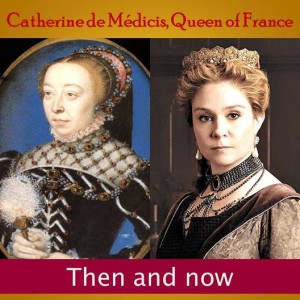 #5 The Confessions of Catherine de Medici by C.W. Gortner: This book includes “the most dramatic events of Catherine’s adult life including the 1572 Bartholomew’s Day massacre of Protestant Huguenots, vividly and chillingly depicted” (~Historical Novel.info). My book-blogger friend Meg at A Bookish Affair notes that, “Gortner is able to humanize the Queen as a person who had seen a lot of trauma in her life” and concludes that Confessions is “perfect for any history lover who wants to see Catherine de Medici in a new light.” Publishers Weekly called Gortner’s novel, “”A remarkably thoughtful interpretation of an unapologetically ruthless queen,” and I must say I quite agree.
#5 The Confessions of Catherine de Medici by C.W. Gortner: This book includes “the most dramatic events of Catherine’s adult life including the 1572 Bartholomew’s Day massacre of Protestant Huguenots, vividly and chillingly depicted” (~Historical Novel.info). My book-blogger friend Meg at A Bookish Affair notes that, “Gortner is able to humanize the Queen as a person who had seen a lot of trauma in her life” and concludes that Confessions is “perfect for any history lover who wants to see Catherine de Medici in a new light.” Publishers Weekly called Gortner’s novel, “”A remarkably thoughtful interpretation of an unapologetically ruthless queen,” and I must say I quite agree.
You can read Meg’s full review here.
♥Unapologetic Catherine admirers, this book is for you!♥
#6 Blood Between Queens by Barbara Kyle (part of her Thornleigh Saga): Do you enjoy a thriller element with your history? Have you been engrossed by the Mary vs. Elizabeth of England plotline in Reign? Then try this book. My friend Nancy Bilyeau (whose own series about Tudor-era England—beginning with The Crown–I adore) called Kyle’s book, “a fast-paced and exciting historical novel that plunges readers into the deadly rivalry of Elizabeth I and Mary Queen of Scots just as the beautiful three-time-married monarch had fled Scotland for her cousin’s kingdom.” If Nancy says it “captures the high-stakes politics of the Tudor court, depicting its most famous personages with both accuracy and imagination,” I guarantee you it does.
♥Recommended for Reign fans who can’t get enough of the Mary vs. Elizabeth battle.♥
#7 A Time For The Death Of A King by Ann Dukthas: Another book-blogger recommendation, this one special for this occasion from Erin of Flashlight Commentary, whose blog I read regularly for her articulate reviews. Dukhas’ YA novel is “one of those books I [Erin] intend to give my kids” (that’s a compelling recommendation). A true mystery investigation that sets out to settle the question of whether Mary Queen of Scots was a murderess, complicit in the death of her second husband, Lord Darnley, “readers will not be disappointed by the swift and lean narrative and the solutions to the historical puzzle Dukthas draws.” [Booklist] Erin loved the time-traveling detective at the center of this mystery, Nicholas Segalla, and“admire[d] how the author’s manipulation of the material deepened the mystery surrounding Darnley’s death while introducing young readers to the powerful legacy of Mary, Queen of Scots.”
♥This book is for the mystery readers among Reign fans, and for those who are ready for the next, Scottish, chapter of Mary’s life.♥
#8 Mary Queen of Scotland and The Isles by Margaret George: I love me some Margaret George (in fact, I am eagerly awaiting her next novel due in 2017)! And I am not alone. Margaret is an iconic figure in historical fiction circles (deservedly so), and more than two decades ago she wove this marvelous fictionalized account of Mary Queen of Scots life basically from womb to tomb. Meg of A Bookish Affair calls George’s novel, “an epic story with thrilling detail!” Kirkus Reviews had this to say of the book, “George has created a lively, gallant Mary of intelligence, charm, and terrible judgment . . . . a readable, inordinately moving tribute to a remarkable queen.” Sounds like OUR Mary, doesn’t it Reign-royals?!
♥Recommended for those who cannot get enough Mary (at nearly 900 pages, this should satisfy your Mary cravings while still keeping you enthralled)♥
#9 The Little Book of Mary Queen of Scots by Mickey Mayhew: This petite (less than 200 pages) volume of popular history is comprised largely of contemporary anecdotes about Mary, and excerpts from letters and rare primary sources. But does discuss our culture’s fascination with the Scottish Queen, including Reign. Historical novelist Philippa Gregory called it, “A bright and breezy account of the complex life of Mary Stuart.”
♥This book is for those who want a non-fiction look at Mary’s life and who don’t have the time to invest in a long read.♥
#10 The Wild Queen: The Days and Nights of Mary, Queen of Scots by Carolyn Meyer (from the Young Royals series). I am closing out my list with this YA novel that comes to me TWICE recommended—first by a big-time Reign fan of my acquaintance (she’s also a history devotee who is always stumping her fellow fans with her “royal pop quizzes”) and second by Erin at Flashlight Commentary. Currently the Amazon #10 Best Seller in Teen & Young Adult Renaissance Historical fiction, this novel follows the recently widowed Mary home to Scotland where she hopes that a new husband will not only help her to secure not only her own throne but allow her to take the crown of England from her cousin, Elizabeth. Too bad, as the back cover reveals, “the love and security she longs for elude her . . . [and she] finds herself embroiled in a murder scandal that could cost her the crown.” Or rather too bad for Mary but NOT for Reign fans because if that doesn’t sound like an episode of the show I don’t know what does!
♥Recommended for Reign watchers wanting “what happens next” for Mary on Scottish soil right now—not in summer of 2017♥
Well that’s it Reign fans and reader-friends . . . ten different ways to get your fix while waiting for the CW to run the next episode. I look forward to hearing your thoughts on the recommendations, and to learning which are your favorites. And in the meantime remember, the Valois are just plain sexier than the Tudors 😉
Marguerite de Valois: Shinning a Light on a Much Maligned French Princess
Light is a frequent literary device. It can be an emblem of hope, a way to see what has been hidden, even a method of symbolically driving back demons. This month a collection of historical novelists, including myself, have decided to use light in all those ways, by creating a weekly blog event (#LightOnOurLadies) to illuminate the historical women at the center of our writings. The main character in my next novel, Médicis Daughter, is profoundly in need of such illumination. 
History has not been kind to 16th century French Princess Marguerite de Valois. In fact, she has been quite viciously misremembered as a wanton and a woman without substance. Before I explain how I think that happened, please allow me to shine a little light on the real Marguerite.
Born at the Château of Saint-Germain overlooking the Seine, as her father had been before her, Marguerite (or Margot as she was affectionately called) was the eighth child of King Henri II of France and Queen Catherine de Médicis. Described by the poet Ronsard as tall and graceful, with fine pale skin, sparkling black eyes, and chestnut hair, Margot stood out even at a Court renowned for its beauties. But she had more than looks going for her—far more. A true granddaughter of François I, Margot was highly intelligent. She loved books, and often got so swept away by them that she forgot to eat or sleep (sound familiar to anyone reading this?). As a mature woman, Margot was a serious and influential force in the literary life of France. A student of more than literature, Margot was a solid classics scholar. She spoke multiple languages fluently, and also had a genuine talent for public speaking. This she was frequently asked to do, often representing one royal brother or another. Finally Margot had a keen grasp of the fine points of statecraft. Arguably her political acumen exceeded that of her brothers, making her the most similar of all her siblings to her strong-willed, politically expert mother, Catherine de Médicis.
Why then, if Margot was as competent as she was pretty is she so little remembered? And when recalled, why is Margot depicted not as she was, but as lascivious and nearly amoral?
To put it simply, Marguerite de Valois was a victim of poor timing. She was born at the end of her dynasty.
When a royal house expires, its last years are generally recounted by people who have political and personal agendas that make it tempting to denigrate their predecessors. Such was the fate of Valois in the late 16th Century. Slander and denigration of royal family began during their lifetimes, largely fed by the tensions and rivalries of a vicious series of wars (the French Wars of Religion) that stretched from the early 1560s beyond the end of the Valois reign. No member of the Valois was exempt from the attacks of gossips, or from the writings of anonymous political pamphleteers. Anti-Valois propagandists seeking to degrade Marguerite chose that easiest and most ancient path for destroying a woman: assertions of rabid sexual desire and wanton conduct.
Slanderous talk about Margot began early among her family’s enemies, but she owes most of the lasting defamation of her character to a single printed work, Le divorce Satyrique. This malicious pamphlet was composed in her lifetime. It mocked and insulted Margot as it set out grounds for a proposed annulment of her marriage to Henri de Bourbon. Margot’s cousin/husband was no longer merely King of the Navarre, but King Henri IV of France—and a king in need of an heir. We all know that a King in need of an heir will do what it takes to be rid of a queen who cannot give him one. So, grounds for an annulment were created and printed. That such a piece of propaganda should have been taken up as fact and treated as history for so long may seem astounding to us today, but early chroniclers of the French court were often not particularly concerned with objectivity. Nor were early historians. As Robert Ja Sealy remarks in The Myth of the Reine Margot, “the documentary sources for our knowledge. . . were written during the wars of religion and, all too frequently are colored by political expediency . . .” Objectivity as a goal rather than a veneer is a rather recent requirement for history and historians. Even some of the histories written in the 19th and early 20th centuries make no pretense at objectivity in recounting the period of the Wars of Religion. Rather, their authors unabashedly announce in their prefaces which side they are on. Margot, considered not a particularly important historical player, remained largely unexamined. The myths about her grew and thrived in darkness.
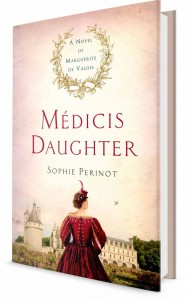 In Médicis Daughter I’ve focused a strong and clear light on the historical Marguerite, creating a coming-of-age story that does her better justice than she received from Valois disparagers, or from those later historians who saw no reason to look more closely. Médicis Daughter releases six weeks from today. To learn more about the book, visit the novel’s page at Amazon, or on Facebook.
In Médicis Daughter I’ve focused a strong and clear light on the historical Marguerite, creating a coming-of-age story that does her better justice than she received from Valois disparagers, or from those later historians who saw no reason to look more closely. Médicis Daughter releases six weeks from today. To learn more about the book, visit the novel’s page at Amazon, or on Facebook.
And now,
As part of the Shining Light on Our Ladies Tour, please meet my fellow authors Helen Hollick and Alison Morton… and their ladies
 Alison Morton is a woman after my own heart.
Alison Morton is a woman after my own heart.
Raised by a feminist mother and an ex-military father, it never occurred to Alison Morton that women couldn’t serve their country in the armed forces. After six years, she left as a captain, having done all sorts of interesting and exciting things she can’t talk about, even now…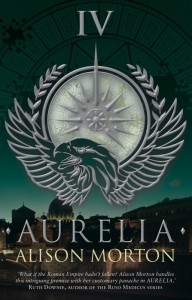
Fascinated by the complex, power and value-driven Roman civilisation since childhood, she wondered what a modern Roman society would be like if run by strong women…
Alison lives in France and writes award-winning Roman-themed alternate history thrillers with tough Praetorian heroines – INCEPTIO, PERFIDITAS, SUCCESSIO and now
… AURELIA: Late in 1960s, Aurelia is sent to Berlin to investigate silver smuggling, former Praetorian Aurelia Mitela barely escapes a near-lethal trap. Her old enemy is at the heart of all her troubles and she pursues him back home to Roma Nova but he has struck at her most vulnerable point her young daughter. Please visit Alison (and Aurelia) to read more – and a chance to win a paperback copy of Aurelia
 Helen Hollick is a fierce advocate for Indie Authors.
Helen Hollick is a fierce advocate for Indie Authors.
She lives on a thirteen-acre farm in Devon, England. Born in London, Helen wrote pony stories as a teenager, moved to science-fiction and fantasy, and then discovered historical fiction. Published for over twenty years with her Arthurian Trilogy, and the 1066 era, she became a ‘USA Today’ bestseller with Forever Queen. She also writes the Sea Witch Voyages, pirate-based fantasy adventures. As a supporter of Indie Authors she is Managing Editor for the Historical Novel Society Indie Reviews, and inaugurated the HNS Indie Award.
On her blog today Helen introduces some ladies from the Court of King Arthur, except this ‘court’ is set in 5th century Britain and her Gwenhwyfar, Morgause and Morgaine are very different from the ladies of the Medieval tales!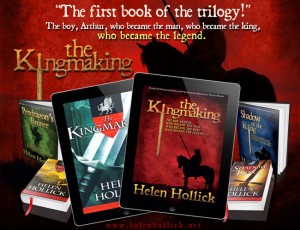
ENJOYING THE SHINING LIGHT ON OUR LADIES TOUR? Then please join us again NEXT TUESDAY when we set sail with Captain Jesamiah Acorne’s ladies aboard Sea Witch, meet a lady surgeon disguised as a man aboard another ship, and are introduced to lady blackmailed into marrying a knight….
A Day in Pompeii
Today we are precisely FOUR WEEKS away from the Launch of “A Day of Fire,” the high-concept novel-in-six-parts that I’ve written with Ben Kane, Kate Quinn, Stephanie Dray, Eliza Knight and Vicky Alvear Shecter. The novel is already available for pre-order at Amazon, but in honor of the countdown to release, I’d like to share some lovely illustrated quotes to give you a taste of the tales the volume contains.
Pompeii was a lively resort flourishing in the shadow of Mount Vesuvius at the height of the Roman Empire. When Vesuvius erupted in an explosion of flame and ash, the entire town would be destroyed. Some of its citizens died in the chaos, some escaped the mountain’s wrath . . . and these are their stories:
A boy loses his innocence in Pompeii’s flourishing streets.
An heiress dreads her wedding day, not knowing it will be swallowed by fire.
An ex-legionary stakes his entire future on a gladiator bout destined never to be finished.
A crippled senator welcomes death, until a tomboy on horseback comes to his rescue.
A young mother faces an impossible choice for her unborn child as the ash falls.
A priestess and a whore seek redemption and resurrection as the town is buried.
Visit “A Day of Fire’s” Facebook page to learn how you could win the book by correctly identifying which author wrote which quote.
My Writing Process
My good friend and “goddess of historical fiction” Kate Quinn tagged me in this cyclical blog tour (make sure you pop over to Kate’s blog and see her answers then follow the chain back for insight into the minds and work habits of other historical fiction luminaries like Christy English and Stephanie Dray). Four questions designed to reveal how we do what we do—write books that is. Answering is harder than you think (as is writing books) because most of us write as we breath—because we are compelled to. And, unless called to account by questions such as these, we don’t think a lot about it.
1) What am I working on?
I am putting the finishing touches on “Daughter of de Médicis: A Novel of Marguerite de Valois” before handing it over to my agent for his input. I consider the book a true bildungsroman, focusing on the psychological and moral growth of the enigmatic Marguerite de Valois from the point at which she comes to live with her brother Charles IX’s royal court as a young girl to the moment when she is transformed by a tremendous historical event (the Saint Barthlomew’s Day massacre in Paris) into an independent adult. I’ve always been fascinated by Marguerite—daughter of a King, sister of three and wife of Henri IV. Had she lived in England Marguerite would have ruled in her turn, but Salic law in France relegated her to the sidelines. Her relationship with her powerful mother, Catherine de Medicis, is an important aspect of the novel. Let’s face it, the mother-daughter relationship is always fraught with peril during the teen years, but imagine if your mother was Catherine de Medicis!
If you are interested in learning more about “Daughter of de Medicis” (including more cool sneak-peek quotes like the one below), it has its own Facebook page.
2) How does my work differ from others of its genre?
Every author’s voice is different. I have mine. You either like it or, perhaps, you do not. But it is different from anyone else’s. Beyond that I cannot opine because I make a conscious effort NOT to compare my work to the work of other historical novelists. In writing as in life I find such behavior is not particularly productive. More than that, it can lead to some pretty negative stuff/feelings. I write for the joy of it. I don’t view it as a competitive sport and I fear indulging in comparisons can too often lead to that.
3) Why do I write what I do?
I write historical fiction because I love to read it. Also because I am a bona fide history geek (have my BA in history) from a family of history geeks (my only sister is actually a Professor of History). When I was a child, I visited historical sites while other kids were at amusement parks. I also grew up watching all those Masterpiece Theater costume dramas of classic literature, and ninety-nine percent of my favorite books were (are) set in the past. So, historical fiction was a natural niche for me. Since I studied French abroad, and I am a devotee of Alexandre Dumas, peré, both my first novel (“The Sister Queens”) and “Daughter of de Medicis” have French history at their centers.
4) How does your writing process work?
“School is my friend.” I bet every parent out there who works at home can identify with that. When my writing is going well, the hours between dropping off and picking up my son from school are devoted 100% to writing. This can have some unfortunate side-effects—usually in the form of the plaintive cries of family members claiming they are, in fact, wearing their last pair of clean underwear. To balance my various roles and not feel like a hamster on a wheel, I try to be fully present and in each given moment. I try not to think “oh my god, you should be writing” when I am not. That kind of thinking tends to just create a guilt-induced writer’s block when I finally sit down at the keyboard. Oh and I don’t compare my daily word count to others—ever. I am a “slow first draft” writer, but the first drafts I eventually produce tend to be close to ready to handover to my critique partners, agent or editor. Finally my process involves weekly summits with a pair of fellow novelist whose work I adore and opinions I respect. We work through problems and set goals—basically we keep each other on-track and honest in a profession that can, by virtue of its solitude, allow for a good deal of procrastination.
Well that’s all she wrote—or rather how she writes (with the “she” being “me). My friend Nancy Bilyeau is up next. On Monday, April 7th she will offer insight into her own creative process, a process that’s led to her gripping Sister Joanna Stafford series (“The Crown” and “The Chalice” with a third installment on the way). Check back here next Monday March 31st, and I’ll link to her site so you can see what her answers are.
Kate Quinn’s Second Borgia Book Is In Stores!
I’ve been so excited for publication of Kate Quinn’s “The Lion and the Rose,” which tells the story of the infamous Borgia family like you’ve never heard it before! And yesterday was “L” Day (that’s Launch Day for the uninitiated) at last. I am fortunate enough to be part of a launch-day triumvirate with Kate and Stephanie Dray–a troika of historical fiction writers dedicated to the premise that no author should be permitted to check her Amazon rankings on the day her book comes out and that a sumptuous lunch is the best preventative. So yesterday I was a lady-who-lunches rather than a lady who writes, abandoning myself to good company and good food and celebrating Kate and this new novel. So I guess I should show and tell a bit. Here’s the cover and the scoop:
Synopsis:
From the national bestselling author of The Serpent and the Pearl comes the continuing saga of the ruthless family that holds all of Rome in its grasp, and the three outsiders thrust into their twisted web of blood and deceit . . .
As the cherished concubine of the Borgia Pope Alexander VI, Giulia Farnese has Rome at her feet. But after narrowly escaping a sinister captor, she realizes that the danger she faces is far from over—and now, it threatens from within. The Holy City of Rome is still under Alexander’s thrall, but enemies of the Borgias are starting to circle. In need of trusted allies, Giulia turns to her sharp-tongued bodyguard, Leonello, and her fiery cook and confidante, Carmelina.
Caught in the deadly world of the Renaissance’s most notorious family, Giulia, Leonello, and Carmelina must decide if they will flee the dangerous dream of power. But as the shadows of murder and corruption rise through the Vatican, they must learn who to trust when every face wears a mask . . .
Some Review Quotes to Tempt you Further:
“Quinn creates memorable and authentic characters who embrace the aura of the era, and still speak to the modern reader’s sensibilitity. Beyond these remarkable people there are lush backdrops, fascinating historical details, and everything from espionage to murder, passion and piety. Quinn makes history accessible and unforgettable with her storytelling.” ~RT Book Reviews
“Beautifully written, and a topic that will open some eyes about the Borgias.” ~Romance Reviews Today
AND an Excerpt
“This is all terribly anticlimactic,” I complained to my mistress. “Captured by enemy forces, and where are the dungeons? The torturers? The chains? At the very least, you should have been sold into the harem of a Moorish merchant prince. That would be a story worth telling.” I hurt too badly to laugh at my own joke, so I gave a shallow sigh instead. “There is no literary scope in spending a few nights drinking French wine with French generals, listening to French compliments, then being escorted back to Rome in luxury.”
“I think it was a trifle more harrowing than that.” Giulia Farnese looked across the carriage at the bandages wrapping my chest and shoulder and hip, the splints a French surgeon had strapped to my broken fingers, the black bruises that covered nearly every visible inch of my flesh like splotches of pitch. “How is the pain, Leonello? And don’t just grit your teeth at me stoically, please.”
“Why, it’s a very splendid pain,” I said airily. “We’ve gotten to know each other very well, really—perhaps I shall give it a name and keep it for a pet when this is all over.” I had been beaten to a pulp by French pike-men, for daring to defend my mistress when French scouts descended like wolves on her traveling party as she made her way toward the Holy City. More precisely, I’d been beaten to a pulp because I’d killed three French pike-men and wounded two more before they brought me down, and such men do not like to be humiliated by a man like me.
I am a dwarf, you see. The kind you see in motley at fairs, juggling wooden balls, only I do not juggle and never have. I have the short bowed legs and the oversized head and the broad torso of my kind, but I also have uncommon skill at throwing knives. I can core a man’s throat like an apple at ten paces, and it was for that skill I was hired as bodyguard to Giulia Farnese, the Pope’s golden mistress. If she’d had a strapping youth for a guard, the French would have killed him at once—enemies fasten first on strapping youths when they look for those who might prove a threat. No one bothers to notice the dwarf.
Not until I kill them, and then it’s too late.
So if that has you itching to read more. Here are a couple of links where you can buy The Lion and the Rose.
